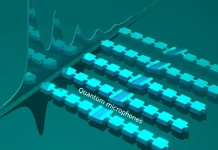
Quantum Information Science is a new field that has the potential to revolutionize science and engineering fields involving computation, communication, precision measurement, and fundamental quantum science. The origins of this field can be traced back approximately twenty years when pioneers such as Charles Bennett, Paul Benioff, Richard Feynman, and others began to consider the implications of combining quantum mechanics with the classical Turing computing machine. Learn more in this article.
Contents
What is Quantum Information Science?
Quantum information science is an interdisciplinary field that uses quantum mechanics principles to understand the analysis, processing, and transmission of information. It combines information science and quantum effects in physics. It covers theoretical issues in computational models and more experimental quantum physics topics, such as what can and cannot be done with quantum information. The term quantum information theory is also used, but it excludes experimental research and can be confused with a subfield of quantum information science that deals with quantum information processing.
How it all Started?
For hundreds of years, our understanding of the properties of matter and energy was based on mathematical equations derived from observations of Nature by Newton, Gauss, Maxwell, and others. These laws provide a valuable model of motion, force, heat, electricity, and magnetism, allowing us to construct engines, power generators, computers, and communication devices.
As we began to observe Nature on atomic and subatomic scales in the twentieth century, it became clear that the classical model was insufficient to predict properties at small distances. Instead, a quantum model was required, introducing implausible features later confirmed in Nature.
The classical model can describe particle systems or waves, but these are two distinct phenomena. Matter in the quantum model has properties of both waves and particles. This behavior allows a system with two classical directions of polarisation (say, “up” or “down”), such as a magnet, to be in a quantum superposition of states, simultaneously polarised both “up” and “down.” forms of multipartite systems can be “entangled,” exhibiting correlations stronger than classical theory allows.
In the twentieth century, we used the quantum model to create new technologies, such as the transistor and the laser, revolutionizing our lives. Likewise, we are starting to use quantum properties in the twenty-first century to build new computers and communication devices. This necessitates an entirely different way of thinking about solving problems with computers, particularly how difficult some problems are to solve.
These are profound questions with practical implications. Cryptography, which allows us to keep sensitive information such as financial or health data private in messages, is based on requiring anyone other than an authorized person to perform a complicated computation to steal the information. The classical model underpins our current concepts of difficulty. Many classically complex analyses are simple in the quantum world.
One of the first applications of quantum devices will be in nature modeling, where the properties and behavior of chemical systems and physical devices will be computed at the quantum level. These are some of the most complex simulations on traditional computers. However, quantum computers have the potential to change the game by enabling more realistic modeling on a practical timescale. Such simulations could have a wide range of applications, including drug design, sustainable energy generation, and the development of new materials.
Research and Development
To comprehend quantum teleportation, quantum entanglement, and the fabrication of quantum computer hardware, a thorough understanding of quantum physics and engineering is required. Since the 2010s, there has been remarkable progress in quantum computer manufacturing, with companies such as Google and IBM investing heavily in quantum computer hardware research. As a result, instructing a quantum computer with more than 100 qubits is now possible. However, the error rate is exceptionally high due to a scarcity of materials suitable for the fabrication of quantum computers. Majorana fermions could be one of the critical materials that are missing.
Quantum cryptography devices are already on the market. For example, there is an old cipher known as a one-time pad that spies widely used during the Cold War. It employs a lengthy sequence of random keys. If two people exchange the duplicate random keys safely, it is only by chance that a one-time pad can be decrypted. However, critical exchanging problems can be solved by trading quantum entangled particle pairs. Quantum mechanical laws like the no-cloning theorem and wave function collapse form the foundation for the secure exchange of random keys. As a result, developing devices capable of transporting entangled quantum particles is an important scientific and engineering goal. Quantum computer programming languages are also required. Popular quantum programming languages include Qiskit, Cirq, and Q Sharp.
Mathematical Subjects
One of the topics covered in algorithms and computational complexity theory is quantum algorithms and quantum complexity theory. Peter Shor, a mathematician, published his prime factorization algorithm in 1994. One can use Shor’s algorithm and a 4,000-logical qubit quantum computer to threaten the most widely used ciphers, such as RSA and ECC. Many countries may face serious security issues as a result. As a result, his paper sparked a surge in investment in quantum computing research. Many mathematicians and cryptologists are gearing up for the arrival of quantum computing.
What will Quantum Information Science do?
One significant development that has fueled the growing interest in quantum information science is forms of computing and information processing that may also be able to overcome the classical physical constraints by quantum effects such effects as “superposition,” in which a quantum system can exist in all possible states until observed, and “entanglement,” in which measuring one member of a paired design causes the other member to immediately assume a corresponding value, regardless of how far apart they are in space. As a result, quantum information science is thought to hold great promise in four critical areas explained below:
- Quantum computing: quantum computing employs qubits instead of bits with values of 1 or 0, which can have intermediate values. While quantum computers are not a replacement for classical computers, they are thought to be extraordinarily powerful at solving specific problems, such as factoring in large numbers and tackling some of science’s long-standing challenges. In addition, they are supposed to be particularly good at simulating actual physical quantum behavior, whether in material or chemical systems.
- Quantum communication: Quantum information systems offer highly secure encryption, a significant draw in an age when cybersecurity is constantly under threat.
- Quantum sensing: Sensors based on quantum effects are extremely sensitive and could aid in understanding everything from biological systems to the Nature of dark matter.
- Quantum foundational science: To expand the application of quantum information science to quantum computing, communications, and sensing, fundamental theoretical and experimental research is required.
Conclusion
Quantum Information Science is a new field of science and technology that integrates physical science, mathematics, computer science, and engineering. Its goal is to understand how specific fundamental physics laws discovered earlier this century could be used to improve information acquisition, transmission, and processing dramatically. This field’s exciting scientific opportunities stimulate the interest of a growing community of scientists and technologists, fostering unprecedented interactions across traditional disciplinary boundaries. In the coming century, advances in Quantum Information Science will become increasingly critical to national competitiveness in information technology.
The information technology revolution of the last several decades has been driven by consistent advances in the miniaturization of electronic circuitry on silicon chips, allowing performance to double every 18 months roughly. However, in less than 20 years, this shrinkage will reach atomic dimensions, necessitating a new paradigm if progress is to continue at the current rate. As a result, significant thought and long-term planning are already being devoted to the challenges of designing and fabricating devices at the atomic scale and getting them to work reliably, a field known broadly as nanotechnology.
However, it has long been known that atoms and other tiny objects obey quantum physics laws that defy common sense in many ways. So observing a bit causes it to spread out and behave as if it were in several different places simultaneously, whereas not watching it causes it to spread out and act as if it were in several other sites simultaneously. Nevertheless, until about five years ago, such quantum effects were mostly regarded as a nuisance, causing small devices to be less reliable and more prone to error than their larger counterparts.
What is novel, and what distinguishes Quantum Information Science from other traditional disciplines, is the realization that quantum effects are not just a nuisance but can be used to perform essential and otherwise impossible information-processing tasks. Quantum effects have already been used to create unbreakable codes, and a quantum computer, if one can be built in the future, could efficiently perform some computations that would take today’s supercomputers longer than the age of the universe. However, the way quantum effects accelerate computation is not a simple quantitative improvement, such as solving a complex problem faster using a faster processor or many processors working in parallel.
Instead, it is a qualitative improvement, similar to the benefit of using decimal numbers instead of Roman numerals when calculating. For the first time, the physical form of information has a qualitative rather than merely quantitative impact on how efficiently it can be processed and what can be done with it.
As a result, aside from its technological implications, Quantum Information Science is an intellectually stimulating field with far-reaching theoretical and experimental consequences on fundamental mathematical and physical sciences. It is already introducing a new language for describing how Nature works and new ways of thinking about a wide range of scientific and technological issues. As with any revolutionary scientific discovery, the long-term implications are difficult to predict, but we are confident they will be profound. We also anticipate that the emergence of Quantum Information Science will have a significant long-term impact on how science is taught at the college and secondary levels, as well as provide a deeper understanding of quantum physics to a large segment of the lay public.
While the potential economic impact of Quantum Information Science is enormous, the issues must be resolved before new quantum technologies can be realized. These problems are broad and deep, encompassing theory, experiment, and engineering. Therefore, laying the groundwork for Quantum Information Science will provide the tools to solve these problems and allow progress toward more specific technical goals.
Because of its long time horizon and inherent interdisciplinary Nature, the development of Quantum Information Science presents unique challenges. Researchers in the fieldwork are on the outskirts of traditional disciplines, making it difficult to obtain funding or advance their careers. The most talented students are drawn to Quantum Information Science by the excitement it creates, but they are unsure how to pursue that interest within a traditional academic department. Worryingly, excellent young scientists who receive advanced degrees in Quantum Information Science research are frequently forced to leave the field due to a lack of stable funding to support their work, despite the apparent relevance of Quantum Information Science to the nation’s long-term economic health.
Sources
- What is quantum information science? | QuICS. (n.d.). QuICS. Retrieved January 25, 2022.
- Nielsen, Michael A.; Chuang, Isaac L. (June 2012). Quantum Computation and Quantum Information (10th-anniversary ed.). Cambridge: Cambridge University Press. ISBN 9780511992773. OCLC 700706156.
- Quantum Information Science. (n.d.). Energy.Gov. Retrieved January 25, 2022.
- A.V. (1999, October 28). Quantum information science. National Science Foundation. Retrieved January 25, 2022.
FACT CHECK: We strive for accuracy and fairness. But if you see something that doesn’t look right, please Contact us.
DISCLOSURE: This Article may contain affiliate links and Sponsored ads, to know more please read our Privacy Policy.
Stay Updated: Follow our WhatsApp Channel and Telegram Channel.











